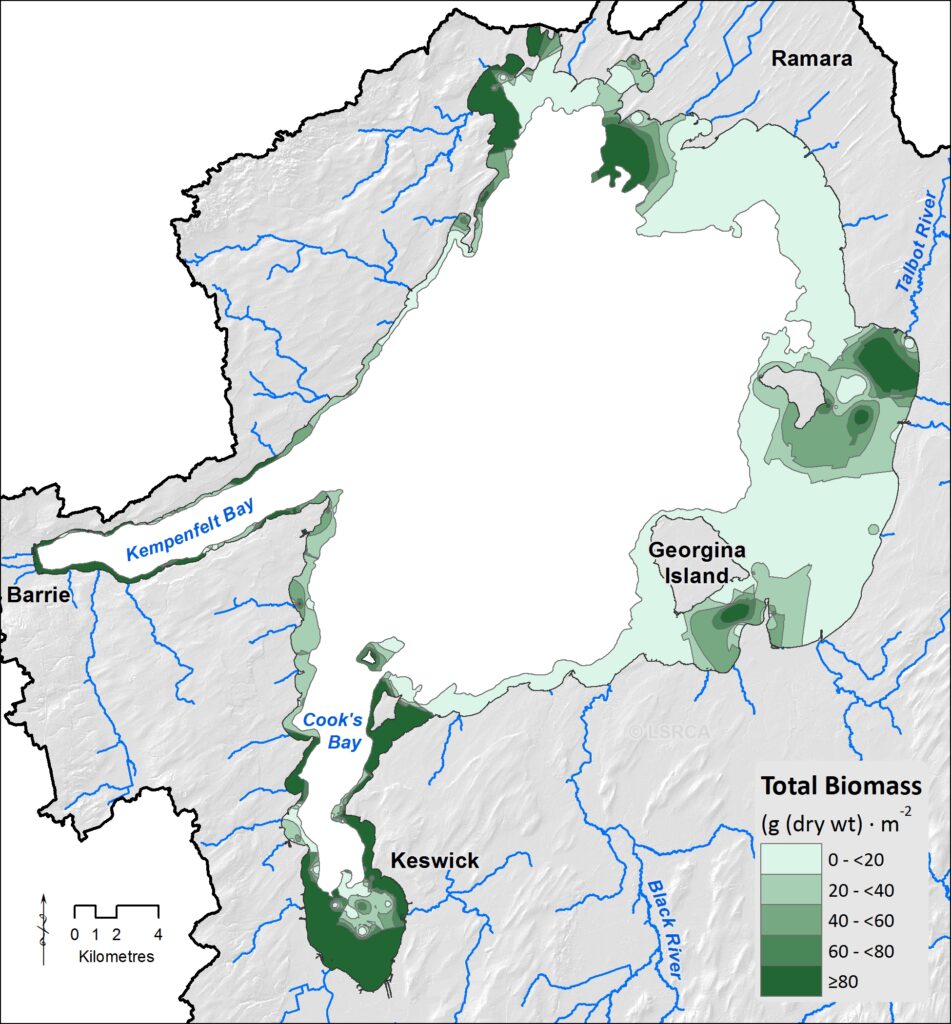Aquatic Plants
A Word on Weeds at Your Waterfront
You may call them “weeds” – a nuisance that is interfering with your enjoyment of the lake or your waterfront. However, almost any plant is considered a “weed” if it is overgrown or unwanted. The “weeds” that accumulate on your shoreline are more accurately called aquatic plants.
There are seventeen aquatic plant species found in Lake Simcoe, although five make up the majority:
We need aquatic plants
Aquatic plants are a natural, normal and necessary part of a healthy lake ecosystem and provide many benefits for aquatic life. They provide fish with a place for shelter, shade and protection, and a place to lay eggs or build nests. They slow the action of waves that erode the shoreline, provide calm areas for sediments to settle to the lake bottom, and their presence also helps protect against invasive plant species.
Aquatic plants are more plentiful along shorelines where there is a gradual slope from shallow to deep, a bottom that is mud, silt, sand or a combination, or have protection from wind and waves such as a sheltering point or enclosed bay.
Shoreline Nuisance?
Aquatic plants tend to accumulate along shorelines:
- That have a gradual slope from shallow to deep.
- Where the bottom is mud, silt or sand.
- That are protected from wind and waves.
Do staff at LSRCA remove the plants from my shoreline?
No. Our approach is on a long-term strategy that focuses especially on phosphorus reduction to address excessive aquatic plant growth.
Advice about removing plants from your shoreline
If you have a lot of aquatic plants along your shore, take care in removing them.
Clearing them as they accumulate on your shoreline is fine, but uprooting them from the lakebed is not. You could end up making the problem worse by scattering fragments of the plants, which can take up root elsewhere. You are also potentially disturbing fish habitat and could be subject to fines for doing so. Fish habitat is protected by Fisheries and Oceans Canada.
Is the entire lake full of aquatic plants?
No. Sometimes when people notice a lot of plants near the shore, they assume that it’s the same throughout the lake. Aquatic plants end up along the shoreline through the natural wave action in the lake. If you live along the east side of the lake, you are more likely to find plants wash up along your shoreline because of the prevailing winds.
In this map, you will see the aquatic plant distribution in Lake Simcoe in 2013.
What’s the cause of too many aquatic plants?
The issue with too many plants along the shoreline is largely a result of two main issues: high phosphorus levels and invasive species.
Phosphorus is a naturally occurring element and is necessary to sustain life. However, too much phosphorus contributes to overgrowth. We have too much phosphorus in the lake largely because of human activities on the land. Increased urbanization, uncontrolled stormwater run-off and agriculture are some of the contributors.
The introduction of the invasive zebra and quagga mussels has contributed to aquatic plant growth as well by increasing water clarity. Invasive mussels are incredibly good at filtering water. Although this might sound like a good thing, the increased clarity lets sunlight penetrate deeper into the water and all that sun encourages plant growth.
Ways to reduce plant growth in Lake Simcoe
We can all work together to support a long-term approach through taking the following steps:
One of the simplest and most effective things you can do is to divert any water that runs off your property onto soil or grass, and away from paved surfaces. For instance, divert your downspouts on to grass and away from the driveway or install a rain barrel to collect water from your roof. Why? Because run-off from hardened surfaces such as roads and driveways doesn’t always get treated before it ends up in the lake. Less water in our storm sewers means less pollution in the lake.
When gardening, use mulch to save on watering, and use compost instead of commercial fertilizer.
Plant native plants in your garden. Native plants are adapted to our climate and therefore need less water or fertilizer once established.
If you must fertilize your lawn, look for phosphorus-free alternatives.
Use household products that are phosphorus-free.
If you’re on septic, make sure you’re undertaking regular maintenance.
Help to prevent soil erosion. Don’t clear-cut vegetation, create steep slopes or mow to the water’s edge.
If you transfer your boat between bodies of water, make sure to clean it thoroughly to prevent the spread of invasive species. Invasive species are almost impossible to remove once they take hold.
The only realistic way of stopping invasive species is through prevention.
Tell others about these tips. We all have a role to play.
![]() Who to Contact
Who to Contact
Customer Service
✆ 905-895-1281
✆ 1-800-465-0437 Toll free
✉ info@LSRCA.on.ca
Interested in receiving updates about Conservation Area news and programs?


